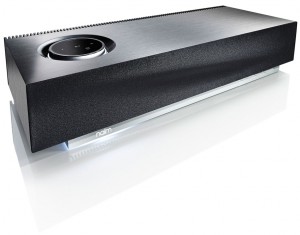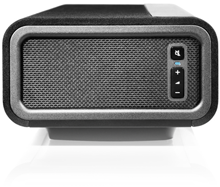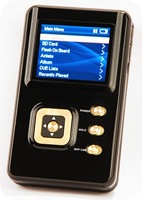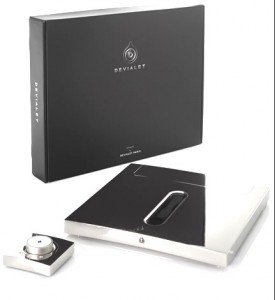




Hifi ubiquity Denon has entered the multiroom streaming scene that Logitech so abruptly left last year. While not the only Sonos alternative around, the Heos is certainly the most affordable and Denon sufficiently household to actually pose a serious competitor of Sonos.
The Heos system consists of a three self-contained speakers not unlike the Play components from Sonos. At the moment there are no reception-only units á la Sonos Connect but given Denon’s serious line-up of hifi-equipment, it would be surprising if they didn’t add a receiver to the system. There is a Heos Amp that can feed a self supplied set of speakers with 2x100w akin to the Sonos Connect:Amp. Everything is controlled by an app for Android or iOS. None for Windows Phone, alas. The Heos system operates on traditional wifi and/or ethernet connections and does not require a bridge, thus also does not ruggedise its streaming by way of a grid such as Sonos.
Supported file formats ranges the usual except high resolution audio and certain levels of DRM. Files can be fetched from network sources or from directly attached media such as USB sticks and optical or analogue inputs and from there shared across the Heos system.
Already announced, according to Recordere.dk, are extra speakers, a subwoofer and a soundbar.
![]()
![]()
![]()
![]()
![]()
 Naim have put a Naim Mu-So up for draws among customers who purchase a Hi-resolution digital album from their music shop. The Mu-So is Naim’s take on a wireless, monolithic speaker to compete with products such as B&W Zeppelin. Inline with Naim’s usual graphic style, the Mu-So has a visual punch unlike most other products in its genre. It streams everything up to 24-bit/192kHz Flac on a wired connection and plays it back at 75W per channel. Unusual among its peers it supports multi-room streaming with more Mu-Sos connected and is controlled by either an iOS or Android device or via the [equally] unusually rudimentary remote that comes with the package.
Naim have put a Naim Mu-So up for draws among customers who purchase a Hi-resolution digital album from their music shop. The Mu-So is Naim’s take on a wireless, monolithic speaker to compete with products such as B&W Zeppelin. Inline with Naim’s usual graphic style, the Mu-So has a visual punch unlike most other products in its genre. It streams everything up to 24-bit/192kHz Flac on a wired connection and plays it back at 75W per channel. Unusual among its peers it supports multi-room streaming with more Mu-Sos connected and is controlled by either an iOS or Android device or via the [equally] unusually rudimentary remote that comes with the package.

 Foobar2000
Foobar2000 Canadian newcomers (and to some extent, former
Canadian newcomers (and to some extent, former 
 Last year audiophile Fang Bian released a first shot at a true high-fidelity portable audio player (we can’t go around calling it an MP3 player now, can we – let alone a walkman!?) with a slightly bulky exterior boasting some really impressive specs. It even had a detachable amplifier section. Now he has gone and done it again, releasing a somewhat smaller but definitely not less impressively spec’d player. The HM-602 uses a Philips TDA-1543 dual DAC to support 24bit/96KHz
Last year audiophile Fang Bian released a first shot at a true high-fidelity portable audio player (we can’t go around calling it an MP3 player now, can we – let alone a walkman!?) with a slightly bulky exterior boasting some really impressive specs. It even had a detachable amplifier section. Now he has gone and done it again, releasing a somewhat smaller but definitely not less impressively spec’d player. The HM-602 uses a Philips TDA-1543 dual DAC to support 24bit/96KHz 
